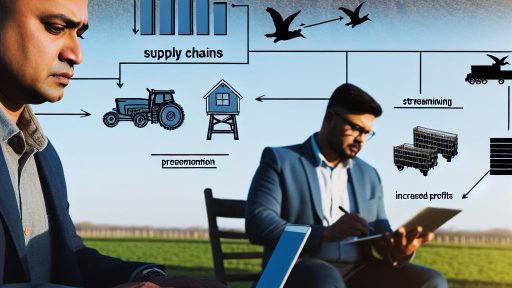Understanding the Fundamentals of Supply Chain Management in Agribusiness
Defining Supply Chain Management
Supply chain management refers to overseeing the flow of goods and services.
It includes all processes that transform raw materials into final products.
This management ensures that products reach consumers efficiently.
The Role of Supply Chain in Agribusiness
In agribusiness, supply chain management plays a critical role.
It integrates production, processing, and distribution activities.
Effective supply chains enhance operational efficiencies and reduce costs.
Key Components of Supply Chain Management
- Production: This involves growing and harvesting crops.
- Processing: Raw products are converted into finished goods.
- Distribution: This part ensures products reach the market.
Each component impacts the overall efficiency of the supply chain.
Importance of Collaboration
Collaboration among participants in the supply chain is essential.
This cooperation leads to improved information sharing and problem-solving.
Moreover, strong relationships can enhance trust and reduce conflict.
Technological Innovations
Technological advancements are reshaping supply chain management.
For example, data analytics helps make informed decisions.
Additionally, automation improves efficiency in processes.
Challenges in Supply Chain Management
Agribusiness supply chains face multiple challenges.
These include market fluctuations and regulatory changes.
Transform Your Agribusiness
Unlock your farm's potential with expert advice tailored to your needs. Get actionable steps that drive real results.
Get StartedFurthermore, weather conditions can impact production schedules.
Identifying Key Stakeholders in the Agribusiness Supply Chain
Understanding Stakeholder Roles
Stakeholders play crucial roles in the agribusiness supply chain.
Each one influences processes from production to distribution.
Recognizing their roles improves collaboration and efficiency.
Primary Stakeholders in Agribusiness
Producers are typically the first link in the supply chain.
They grow and harvest crops or raise livestock for sale.
Subsequently, processors transform raw materials into products.
These products often require packaging and branding.
Distributors then handle the logistics of getting products to consumers.
Retailers sell these products, making them accessible to customers.
Consumers complete the chain by purchasing and utilizing these goods.
Supporting Stakeholders
Beyond primary stakeholders, supporting roles are essential.
Service providers include agronomists and veterinarians who offer expertise.
Technology providers supply necessary tools for efficiency.
Financial institutions help fund operations and investments.
Government agencies regulate practices and ensure compliance.
Engaging with Stakeholders
Effective communication fosters stronger relationships among stakeholders.
Regular meetings and updates keep all parties informed.
Utilizing technology enhances collaboration and data sharing.
Transparency builds trust and helps identify common goals.
Strategies for Stakeholder Identification
Begin by mapping out the supply chain’s flow of goods.
Identify who plays a role at each stage of this flow.
Engage in stakeholder analysis to prioritize their influence.
Consider using surveys or interviews to gather insights.
Showcase Your Farming Business
Publish your professional farming services profile on our blog for a one-time fee of $200 and reach a dedicated audience of farmers and agribusiness owners.
Publish Your ProfileThis process helps tailor strategies for effective engagement.
Evaluating Supply Chain Risks and Mitigation Strategies
Understanding Supply Chain Risks
Supply chain risks significantly impact agribusiness operations.
These risks can arise from various sources, including natural disasters and market fluctuations.
Additionally, regulatory changes can introduce unexpected challenges.
Research indicates that understanding these risks is vital for effective management.
Identifying Potential Risks
Start by identifying the key components of your supply chain.
Consider factors such as suppliers, transportation, and market demand.
Map out potential vulnerabilities associated with each component.
For instance, geographic locations may expose suppliers to environmental hazards.
This assessment can employ tools like SWOT analysis for a comprehensive view.
Implementing Mitigation Strategies
Developing mitigation strategies helps reduce supply chain vulnerabilities.
Begin by diversifying your supplier base.
This approach minimizes reliance on a single source, increasing resilience.
Moreover, consider developing contingency plans for disruption scenarios.
These plans should include alternative logistics and communication protocols.
Monitoring Supply Chain Changes
Regular monitoring of supply chain dynamics is essential.
Utilize technology to track changes in market conditions and supplier performance.
Consider adopting software tools that provide real-time data analytics.
This proactive approach aids in quickly identifying risks and responding effectively.
Training and Education
Investing in employee training enhances risk management capabilities.
Ensure staff understand the importance of supply chain integrity.
Conduct workshops that cover risk analysis and mitigation techniques.
Furthermore, encourage a culture of open communication regarding potential risks.
Engaging with Stakeholders
Collaboration with stakeholders is crucial for effective risk management.
Share risk assessments and mitigation plans with suppliers and customers.
This transparency fosters trust and collective problem-solving.
Consider forming partnerships for resource sharing during crises.
Find Out More: Risk Management Techniques For Stable Agricultural Operations
Implementing Technology Solutions for Enhanced Supply Chain Visibility
Importance of Supply Chain Visibility
Supply chain visibility is crucial in agribusiness.
It helps businesses track products from farm to table.
Transparency fosters trust among stakeholders.
Moreover, it enables timely decision-making.
Technological Tools to Improve Visibility
Several technology solutions enhance supply chain visibility.
For instance, GPS technology provides real-time tracking.
IoT devices monitor conditions during transport.
Cloud-based platforms allow data sharing across teams.
Data Analytics for Informed Decisions
Data analytics plays a vital role in supply chain management.
Analyzing data reveals trends and patterns.
This information helps organizations optimize operations.
Furthermore, predictive analytics can forecast demand.
Showcase Your Farming Business
Publish your professional farming services profile on our blog for a one-time fee of $200 and reach a dedicated audience of farmers and agribusiness owners.
Publish Your ProfileIntegrating Blockchain Technology
Blockchain technology offers a secure way to enhance visibility.
It creates an immutable record of transactions.
This ensures authenticity and traceability of products.
Thus, stakeholders can verify product origins effortlessly.
Enhancing Collaboration with Technology
Effective collaboration is critical in the supply chain.
Technology enables seamless communication among partners.
Collaboration tools streamline workflows and improve efficiency.
Moreover, it fosters innovation and quick problem-solving.
Gain More Insights: Creating Engaging Farm Tours To Enhance Visitor Experience
Best Practices for Inventory Management in Agribusiness
Importance of Accurate Inventory Tracking
Accurate inventory tracking is essential for successful agribusiness operations.
It enables effective management of resources and finances.
Moreover, it helps in preventing overstocking and stockouts.
Utilization of Inventory Management Software
Employ inventory management software to streamline processes.
This technology provides real-time insights into stock levels.
Additionally, it allows for better forecasting of demand.
Implementing FIFO (First In, First Out) Method
Utilize the FIFO method to manage perishable goods efficiently.
This technique helps in reducing spoilage and waste.
It ensures older stock is sold before newer inventory.
Regular Audits and Reviews
Conduct regular audits to maintain inventory accuracy.
Reviews allow for adjustments based on market trends.
Additionally, they help identify discrepancies promptly.
Establishing Supply Chain Relationships
Build strong relationships with suppliers and distributors.
Good relationships enhance communication and trust.
They also facilitate timely deliveries of goods and services.
Training Employees on Inventory Management
Train employees on best practices in inventory management.
This training should cover software usage and stock handling procedures.
Furthermore, it promotes accountability and efficiency among staff.
Utilizing Data for Decision Making
Leverage data analytics to inform inventory decisions.
Data-driven decisions improve overall operational efficiency.
Additionally, they provide insights into consumer behavior and market trends.
Setting Par Levels for Inventory
Establish par levels to maintain optimal inventory levels.
These levels indicate the minimum quantity of stock required.
Setting par levels aids in avoiding surplus or shortages.
See Related Content: Data-Driven Strategies for Successful Agribusiness

Sustainability Considerations in Agribusiness Supply Chains
Importance of Sustainable Practices
Sustainable practices enhance the efficiency of agribusiness supply chains.
They reduce waste and lower environmental impact.
Furthermore, adopting these methods fosters a positive brand image.
Integrated Supply Chain Management
Integrating sustainability into supply chain management is crucial.
This approach encourages collaboration among stakeholders.
Effective communication helps identify sustainability challenges.
Showcase Your Farming Business
Publish your professional farming services profile on our blog for a one-time fee of $200 and reach a dedicated audience of farmers and agribusiness owners.
Publish Your ProfileUltimately, it leads to more innovative solutions.
Adoption of Technology
Technology plays a vital role in achieving sustainability goals.
For instance, precision farming uses data to optimize resources.
Additionally, blockchain enhances transparency across the supply chain.
Such technologies empower farmers and companies to make informed decisions.
Sourcing Sustainable Materials
Sourcing sustainable materials is essential for reducing environmental impact.
Farmers should prioritize eco-friendly practices in sourcing inputs.
They can promote certified organic and local products.
This strategy can enhance consumer trust and satisfaction.
Measuring Sustainability Performance
Monitoring sustainability performance ensures accountability.
Key performance indicators help track progress effectively.
Instituting regular audits can identify areas needing improvement.
Thus, businesses can adapt strategies as necessary.
Engaging with Local Communities
Engaging with local communities fosters sustainable practices.
This collaboration drives shared goals and local development.
Furthermore, it encourages responsible sourcing and production.
Ultimately, local partnerships can enhance supply chain resilience.
Delve into the Subject: Soil Health Management Practices for Sustainable Farming
Collaboration and Communication Strategies Among Supply Chain Partners
Importance of Communication
Effective communication enhances relationships among supply chain partners.
It builds trust, which is vital for successful collaborations.
Additionally, clear communication minimizes misunderstandings.
Regular updates help partners stay informed about changes.
Ultimately, open lines of communication improve decision-making.
Building Collaborative Relationships
Establishing collaborative relationships requires commitment from all parties.
First, partners should outline common goals and objectives.
Next, mutual respect is essential for collaboration to thrive.
Moreover, consistent engagement fosters stronger partnerships.
Sharing resources can lead to more innovative solutions.
Utilizing Technology for Effective Collaboration
Technology plays a crucial role in enhancing communication.
Using cloud-based platforms allows real-time data sharing.
Collaborative tools streamline project management processes.
Video conferencing enables virtual meetings without geographical limitations.
Investing in technology can significantly boost operational efficiency.
Implementing Regular Feedback Mechanisms
Regular feedback is essential for continuous improvement.
Partners should conduct scheduled reviews of collaboration efforts.
This creates opportunities for learning and adjustment.
Moreover, constructive feedback promotes accountability among partners.
Incorporating suggestions can lead to better outcomes.
Encouraging Cross-Functional Teams
Cross-functional teams enhance problem-solving capabilities.
These teams bring together diverse expertise from different areas.
Showcase Your Farming Business
Publish your professional farming services profile on our blog for a one-time fee of $200 and reach a dedicated audience of farmers and agribusiness owners.
Publish Your ProfileEncouraging participation from all levels fosters inclusivity.
Furthermore, collaboration across functions drives innovation.
Ultimately, it aligns efforts towards common business goals.
Key Performance Indicators for Monitoring Supply Chain Efficiency
Introduction to KPIs
Key Performance Indicators (KPIs) are vital for assessing supply chain performance.
They provide measurable values to monitor efficiency.
By using KPIs, agribusinesses can identify areas needing improvement.
Types of Key Performance Indicators
Numerous KPIs exist to measure different aspects of the supply chain.
Some common types include productivity, quality, and delivery metrics.
Each KPI offers unique insights into supply chain operations.
Productivity KPIs
Productivity KPIs measure output relative to input in the supply chain.
Examples include units produced per labor hour.
Monitoring productivity helps businesses maximize resource allocation.
Quality KPIs
Quality KPIs assess the standard of products and services delivered.
Common quality metrics include defect rates and customer satisfaction scores.
Tracking quality ensures that agribusinesses meet customer expectations.
Delivery KPIs
Delivery KPIs focus on the timeliness and reliability of shipments.
On-time delivery rate is a crucial metric in this category.
Improving delivery KPIs can enhance customer satisfaction and loyalty.
Benefits of Monitoring KPIs
Monitoring KPIs offers numerous advantages for agribusinesses.
Firstly, it fosters proactive decision-making.
Data-driven insights lead to more effective strategies.
Additionally, consistent KPI tracking promotes accountability among teams.
This accountability drives continuous improvement across the supply chain.
Implementing KPI Tracking
To effectively track KPIs, businesses need proper tools and systems.
Investment in technology can facilitate real-time data collection.
Additionally, training staff on KPI importance ensures alignment with goals.
Regularly reviewing KPIs allows for adjustments to strategies as necessary.
Importance of KPIs in Agribusiness Success
KPIs are essential for monitoring supply chain efficiency in agribusiness.
By understanding and tracking these indicators, businesses can achieve greater success.
Additional Resources
Implementing the National Strategy | odphp.health.gov
From Supply Push to Demand Pull: Agribusiness Strategies for …




